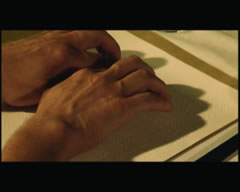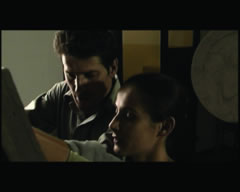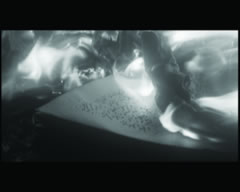
The fortuitous finding of a music score and Giacomo's friendship
lead Anna, a musician, in a "memory room" where the past and the present
communicate and together reanimate, in the darkness, the brilliant Louis
Braille, inventor of the alphabet bearing his name.
Alberto Borghi
A day outside. In the background, the beautiful Santo Stefano Basilica emerges from the crowd of curious, regular customers in the antique market in front. It is a beautiful sunny day and Anna is relaxing, enjoying her own passion for old books. Her practiced musician's eye falls on a pile of musical scores, yellowed by time. She bends to pick them up and to examine them more attentively. She hesitates a moment, but the antique dealer being close on her heels, she decides to buy them. A few hours later, while doing practices with a quartet of baroque music, Anna notices, among the musical scores she just purchased, a few sheets of paper showing no obvious graphical signs. She takes them into her hands and realizes that the papers show designs in relief.
This is how
the film Echoes in the Night begins, Enza Negroni's last work, produced by the
Carisbo Foundation of Bologna and the Istituto dei Ciechi Francesco
Cavazza, to celebrate the merits of Louis Braille on the occasion of the 150th
anniversary of his death. This short film by the Bolognese artist, stage-trained
at DAMS, was directed by executive producer Nelson Bova of Sequence. The
backgrounds for the takes are streets and areas of Bologna (numerous scenes were
filmed in the illustrious Istituto Cavazza on Via Castiglione) but without doing
it too much so that it is possible to identify the story with places that are so
dear to us. It provides the right emphasis on the universal reach of Louis
Braille's intuition, going beyond geographical and cultural barriers.
Louis Braille
appears in the movie playing the organ for which he was well-known and sought
after. In his presence, and listening attentively, is Docteur Pignier, Director
of National Institute for the Young Blind, where young Louis was living,
following the domestic incident that caused the loss of his sight.
Louis is
a very smart young man and he quickly attracts the attention of Dr Pignier and
the teaching personnel, as well as the interest of the Marquis d'Orvilliers,
thanks to whom Louis was able to attend the prestigious and costly Parisian
institution. He plays by ear, but that leaves him dissatisfied. He still has to
compose and translate in writing, words and emotions, music and phonemes. He was
taught the system designed by Valentin Hauy, in reality a simple transposition
of the alphabet in raised lines, which did not make it less difficult for a
blind person to accomplish reading a number of necessary volumes representing
even a simple text.
At the
institute, the young Braille meets Charles Barbier de la Serre, a military man
who had thought up a system useful to communicate during the night in wartime.
Barbier's invention attracts Louis' attention because of the combinations of
raised dots used to reproduce the various phonemes in the French language, which
allow a rapid and efficient transcription of whatever sentence, with the help of
a simple perforated sliding lath. Louis is not satisfied with
this. Sensitive and curious, he cannot do without punctuation marks,
numbers or musical symbols, which were ignored in the simple wartime method. He
reduces the number of dots used, creating a group of letters formed by
combinations of dots, which can easily be recognized by the touch. He uses the
four dots from the upper part of a cell to represent the first ten letters of
the Latin alphabet, and methodically uses the two dots at the bottom to
represent letters from the eleventh to the twentieth. In 1825, at only
sixteen years old, Louis Braille has codified the alphabet; in 1828, he solved
the problems concerning music, and in 1829, he completes the first manual about
his system. His thin and pale figure stands out in its heroic tones
with the use of the black and white flashback technique. Fragments of a life
dedicated to others, and determinant to the faith of millions of people, are
reflected in a few scenes. There is, for example, a protest, however heedless
and short-lived, which exploded among students of the institute following the
decision, taken by the new Director Dufau, to abolish the code created by
Braille.
His thin and pale figure stands out in its heroic tones
with the use of the black and white flashback technique. Fragments of a life
dedicated to others, and determinant to the faith of millions of people, are
reflected in a few scenes. There is, for example, a protest, however heedless
and short-lived, which exploded among students of the institute following the
decision, taken by the new Director Dufau, to abolish the code created by
Braille.
Sighted persons do not understand, using their own perspective, that what is intuitive to them is not necessarily so to the non sighted. Difficulties in communication arise, originating from motivations which do not take into consideration the lack of a sensorial ability. An intuition and a sensitivity emerge, born out of the richness of an interior world which does not want to accept limitations. Destinies crossing, winding into spirals of indeterminate contours. Emotions which do not need an alphabet that is not the language of the soul.
Anna doesn't
know the world of the non-sighted. But she speaks the language of music. The
musical scores she has found hide a mystery which can be unveiled to anyone who
wants to know. With intuition, this unknown world will open up. She knows
Giacomo, a blind professor at the Istituto dei Ciechi Francesco Cavazza. A new
light, a wordless emotion, a subtle curiosity is linking them, bringing them
together.
Louis is playing the organ, the church is enveloped in a passionate
wave. Giacomo plays the piano. He does not yet know that these musical scores
are the works of composition by Carlo Grimaldi, student at the Istituto Cavazza
at the end of the 1800's. He does not yet know that he will complete them,
sitting in front of the piano and of the special Braille computer keyboard. At
the same time he know that Anna is there, only an e-mail away. An
invitation and dinner with the pianist will be for Giacomo another occasion of
emotional and artistic interest. A meeting of interests and emotions. Anna is
taken by Giacomo's charm, by his independence and his thirst for knowledge which
knows no barriers.
She observes his most simple gestures, even those she
would not have thought possible for a person like Giacomo. Anna continues to
watch him, and with time defines the essence of the young professor, who has an
intense dislike for the simplistic recognition of an objective fact, the lack of
sight. The same curiosity which animated Braille pushes Giacomo to learn and
create, and Anna to deepen her knowledge of a system allowing a different way of
deciphering thoughts and emotions. The young man speaks to her about Louis
Braille, accompanies her into the rooms of a collective memory, cultivated by
the experts of his brilliant idea. She succeeds in catching a glimpse of him in
the dark areas of the Parisian college, not always salubrious, while he
composes, plays, reads and writes, learns and teaches.
The
scenography of the short film was written by Enza Negroni and Silvia Colombini,
and was pre-selected among other competing titles in the competition opened by
the Carisbo Foundation and the Istituto Cavazza. Of course, it is no surprise
that the works of Negroni was chosen for the undoubted quality of the project
and its director, noticed by the public also because of the commercial success
and appreciation by the critic (she has won numerous awards at the national and
European levels) of Jack Fruscianate e' uscito dal gruppo, based on the best
seller from Bolognese writer Enrico Brizzi. Enza Negroni was for many years the
Director of the Laboratorio Cinematografico Pilastro of the City of Bologna. She
has written and directed signature tunes, commentaries, documentaries and short
films. She believes in her social commitment from which she takes inspiration
and energy, without neglecting any aspect of her work (for example, the short
films dedicated to the supporters of basketball and soccer was produced with
their own active contribution). She now
manages the lab Fiction dei Laboratori Sperimentali Audiovisivi promoted by the
City of Bologna. As usual, a close attention to details was given, especially
with the historical environment in which Braille lived. From a German
bookseller, for example, was obtained a series of lithographs of tablets used by
Braille himself. The main actors (from theatre) are Rossella Dassu, Filippo
Plancher, Marco Cavicchioli and Marco Cortinovis with the participation of Paolo
Maria Veronica. Photography is by Gigi Martinucci, and sound by Enrico Medri.
Editing is by Davide Pepe.
She now
manages the lab Fiction dei Laboratori Sperimentali Audiovisivi promoted by the
City of Bologna. As usual, a close attention to details was given, especially
with the historical environment in which Braille lived. From a German
bookseller, for example, was obtained a series of lithographs of tablets used by
Braille himself. The main actors (from theatre) are Rossella Dassu, Filippo
Plancher, Marco Cavicchioli and Marco Cortinovis with the participation of Paolo
Maria Veronica. Photography is by Gigi Martinucci, and sound by Enrico Medri.
Editing is by Davide Pepe.
We will not
reveal the end of the film, which we invite you to see (it will also be
presented on television, but cinéma d'auteur is art and, as such, should be
enjoyed in the proper environment). But, we will tell you that Braille's life
ended in 1852 at only 43 years of age. His native home in Coupvray was
transformed into a permanent museum, visited by a lot of people, many of whom
want to express their personal gratitude. France has paid tribute to Louis
Braille by having his body, first buried in his hometown, interred in the Paris
Pantheon, together with the most illustrious personalities of the
nation.